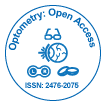Tele-Optometry: Revolutionizing Eye Care Through Technology
Received: 03-Mar-2025 / Manuscript No. omoa-25-170226 / Editor assigned: 05-Mar-2025 / PreQC No. omoa-25-170226 / Reviewed: 18-Mar-2025 / QC No. omoa-25-170226 / Revised: 23-Mar-2025 / Manuscript No. omoa-25-170226 / Published Date: 29-Mar-2025 DOI: 10.4172/2476-2075.1000303
Introduction
Tele-optometry is a branch of telemedicine that leverages digital technology and telecommunications to deliver eye care services remotely. It has emerged as a transformative solution to address the growing demand for accessible, affordable, and timely eye care, especially in underserved or rural areas. With the rise of digital health tools and the global shift toward virtual healthcare models—accelerated by the COVID-19 pandemic—tele-optometry is becoming an integral part of modern optometric practice [1],[2].
Discussion
Tele-optometry encompasses a wide range of services, including virtual eye consultations, remote vision screenings, follow-up care, and even remote refraction and prescribing of corrective lenses. Using high-resolution cameras, digital slit lamps, and secure video conferencing platforms, optometrists can examine patients and assess eye health conditions from afar. Additionally, patients can use smartphone applications and at-home testing kits to perform basic vision assessments before consulting with a practitioner [3],[4].
One of the primary benefits of tele-optometry is increased accessibility. Populations in remote areas, nursing homes, or those with mobility issues often face barriers in reaching traditional eye care clinics. Tele-optometry eliminates the need for travel and allows patients to receive care from the comfort of their homes. This approach not only reduces costs but also helps in early detection and management of conditions like diabetic retinopathy, glaucoma, and macular degeneration [5],[6].
Another key advantage is the efficiency it brings to healthcare delivery. Routine check-ups and follow-up appointments that do not require in-person diagnostics can be conducted virtually, freeing up time and resources in clinics for more complex cases. Tele-optometry also facilitates collaboration among eye care professionals, enabling real-time sharing of patient data, imaging, and opinions for more comprehensive care [7],[8].
However, despite its benefits, tele-optometry does face limitations. Not all eye conditions can be diagnosed or treated remotely. Certain procedures, like dilation and in-depth retinal examinations, still require in-person visits. Moreover, there are challenges concerning technology access, internet connectivity, and digital literacy, particularly among elderly patients. Privacy concerns and regulatory differences between regions may also complicate implementation [9],[10].
Conclusion
Tele-optometry is reshaping the future of eye care by making it more accessible, efficient, and patient-centered. While it cannot replace all aspects of traditional optometry, it serves as a powerful complementary tool that enhances service delivery and expands the reach of care. As technology continues to advance and healthcare systems adapt to hybrid models, tele-optometry is poised to play a critical role in addressing the growing global demand for eye care. Ensuring equity in access, proper training for practitioners, and adherence to regulatory standards will be vital to fully harness its potential and improve vision health outcomes worldwide.
References
- Shewen PE, Povey RC, Wilson MR (1980) A survey of the conjunctival flora of clinically normal cats and cats with conjunctivitis. Can Vet J. 21: 231–233.
- Lilenbaum (1996) Prevalence of bacteria in the conjunctival sac and on the eyelid margin of clinically normal cats. J Small Anim Pract. 37: 364– 366.
- Lilenbaum W, Nunes ELC, Azeredo MAI (1998) Prevalence and antimicrobial susceptibility of staphylococci isolated from the skin surface of clinically normal cats. Lett Appl Microbiol. 27: 224–228.
- Hartmann AD, Hawley J, Werckenthin C, Lappin MR, Hartmann K (2010) Detection of bacterial and viral organisms from the conjunctiva of cats with conjunctivitis and upper respiratory tract disease. J Feline Med Surg. 12: 775–782.
- Lee-Fowler T (2014) Feline respiratory disease: What is the role of Mycoplasma species? J Feline Med Surg. 16: 563–571.
- Płoneczka-Janeczko K, Kiełbowicz Z, Bania J, Bednarek K (2011) Real-time PCR detection of Mycoplasma felis in domestic cats suffering from chronic conjunctivitis (Poland). Pol J Vet Sci. 14: 679–681.
- Low HC, Powell CC, Veir JK, Hawley JR, Lappin MR (2007) Prevalence of feline herpesvirus 1, Chlamydophila felis, and Mycoplasma spp DNA in conjunctival cells collected from cats with and without conjunctivitis. Am J Vet Res. 68: 643–648.
- Haesebrouck F, Devriese LA, van Rijssen B, Cox E (1991) Incidence and significant of isolation of Mycoplasma felis from conjunctival swabs of cats. Vet Microbiol. 26: 95–101.
- Gruffydd-Jones T, Addie D, Belak S (2009) Chlamydophila ´ felis infection ABCD guidelines on prevention and management. J. Feline Med Surg. 11: 605–609.
- Di Francesco A, Piva S, Baldelli R (2004) Prevalence of Chlamydophila felis by PCR among healthy pet cats in Italy. Microbiologica. 27:199–201.
Citation: Komal R (2025) Tele-Optometry: Revolutionizing Eye Care Through Technology. Optom Open Access 10: 303. DOI: 10.4172/2476-2075.1000303
Copyright: © 2025 Komal R. This is an open-access article distributed under the terms of the Creative Commons Attribution License, which permits unrestricted use, distribution, and reproduction in any medium, provided the original author and source are credited.
Select your language of interest to view the total content in your interested language
Share This Article
Recommended Journals
Open Access Journals
Article Tools
Article Usage
- Total views: 317
- [From(publication date): 0-0 - Dec 20, 2025]
- Breakdown by view type
- HTML page views: 249
- PDF downloads: 68
